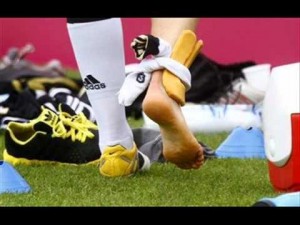Ankle taping is a fundamental aspect of a soccer players ritual. It provides stability of the joints and muscles, acting as a necessary preventative measure for injuries in the sport. The process is similar for all other high impact sports, such as football, basketball. Each sport can require different methods for ankle and joint taping, which can help explain the vast amount of money that is being funneled into the process by professional teams. Making sure that you get the process right can improve both performance and durability.
Professional players tend to be required to tape their ankles and other danger prone joints, but amateur players usually leave ankle wraps until after they have been injured. This is a poor decision, as taping before any injury occurred would have acted as a preventative measure. While it may be a difficult process to become accustomed to, it is absolutely necessary for athletes of all levels to wrap their ankles before and type of intensive physical activity.
Following these five tips can greatly aid soccer players of all levels in taping their ankles and protecting their bodies.
Ankle Braces
 There are many different materials and products out there that can be used to act as foot wrapping and dressing. There are some forms of athletic ankle supports that act as pre-made dressing and wraps that can be slipped on your foot. These will eliminate any confusing styles you may run in to when taping your ankle.
There are many different materials and products out there that can be used to act as foot wrapping and dressing. There are some forms of athletic ankle supports that act as pre-made dressing and wraps that can be slipped on your foot. These will eliminate any confusing styles you may run in to when taping your ankle.
The advantages of using these products are that they are easy to obtain and no medical professional or knowledge is needed to apply them.
The disadvantages, however, are that they can be expensive to buy. In addition, because they are pre-made, they are not personalized to the contours of your feet and ankles. This may be a problem and take away from the preventative effects that the product can have.
Full Ankle Wrapping
This is a method that is used to prevent an inversion injury that is used by many of the worlds elite soccer players. First, start at the forefoot, or at about the arch. Next, guide the tape diagonally up the foot and around the back of the heel bone. Next, go around the top of the mid-foot, and under the foot again, trying to get as much coverage as possible. Next, go around the heel, and repeat a similar process until the ankle is fully wrapped. Using this method, you are guaranteed full coverage of the ankle, maximizing the support you receive. The disadvantage, however, is that is may take the longest for an athlete, especially an inexperienced one, to become accustomed to this feeling.
Figure 8 Wrapping
This is a method that has a reputation for discomfort, as it provides a strange sensation on the users heel. However, it is very easy to create and is useful when you’re short on time. First, as before, start at the forefoot. Then, pull the wrapping steeply enough to go high above the heal and around the lower calf. Make a full circle around the calf, and then pull it down towards the mid-foot. Repeat the beginning process, where you pull it around the fore-foot and up towards the lower calf. Leave the heel of your wrapped foot open. This easy wrap can be quick, but uncomfortable.
Use Proper Materials
Using quality materials can go a long way when you are taping your ankles. In addition, different materials have different needs and applications. For example, cohesive elastic bandages bonds to itself, requiring no additional tape to hold it together. Underwrap, on the other hand, should be used as a supplement to other tape for sensitive areas. Zinc Oxide Tape is h2 and resilient, requiring no addition reinforcement. Use the correct taping for the correct situation.
Proper Taping Practice
There are some rules to follow when taping. For example, always see a medical professional if you are in pain. Make sure that the tape is applied smoothly to a clean and dry area. Ensure that the circulation of the players foot is not damaged and that sensation of the extremity is not damaged or cut off.
